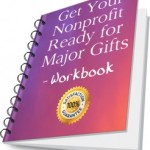Everyone wants to develop a major gifts program. Or to strengthen their existing major gifts program. Why? Because they want to raise more money.
If you approach major gifts development solely from this perspective you’ll ultimately fail.
You might raise more money for a little while. But over the long-term you’ll lose more support than you gain. Because it’s not just about money.
Successful, lifelong major donor relationships are about two things:
(1) Impact
(2) Gratitude
Effective fundraising is about uncovering people who share the values your organization enacts; then making a match that enables these people to do something about which they’re passionate. Yes, they end up giving you money to accomplish this end. But it’s not about money. It’s about the impact this money will make. It’s about feeding a hungry family. Saving a grove of trees. Helping an abused woman and child find refuge. Curing a disease. Righting a wrong.
Once the gift is made, your job is to show your donor the impact their gift made. To demonstrate gratitude for that impact. To show them again so they’re reminded of the benefits of their investment. To thank them again so they feel truly appreciated.
Then, when you think your donor is filled to the brim with the joy of giving, and is ready to re-enact their passion, you show them a way they can do it all over again.
Let’s take a closer look at what it takes to build a rich, rewarding relationship with donors you hope to move towards increasing levels of commitment with your charity.
The Right Way to Approach Major Donor Development
First, you must understand your goals:
- Find an impact to bring donors joy.
- Authentically demonstrate how your donor makes a difference.
- Always think from your donor’s perspective.
- Reach out proactively to help donors joyfully enact their passions.
Find an Impact to Bring Donors Joy
Passionate philanthropy is a joyful experience. Giving, according to research, lights up pleasure centers of the brain and releases endorphins that give you joy. When you show your donors what they can do to be the change they want to see, you’re also making a gift. To do so thoughtfully, you must first become adept at sussing out what your donors cherish. Then figure out what your organization does that aligns with their values and passions. This can be accomplished through a planned cultivation and stewardship program often known as ‘moves management.’
Authentically Demonstrate How Your Donor Makes a Difference
Donors give because they want to make a difference. And they want to be appreciated for caring enough to put their money where their mouth is. You have to mean it; no fake thank-you’s. You can’t be thinking raising money is a ‘necessary evil.’
This is why it’s so important to channel an attitude of gratitude at all times. Think. Really think. What is it about your donor that you’re grateful for? Then you can tell your donor and come across as genuine. And your donor will feel happy and fulfilled. They’ll know they made a good decision to invest with you.
Always Think From Your Donor’s Perspective
Before you do anything, ask yourself “What will the donor think? What will the donor feel?” This often means tailoring your approach to align with your donor’s preference. It means giving your donor options. Not insisting they make unrestricted gifts or gifts to programs other than those where their passions lie. This means thinking about how you would feel if the cultivation or solicitation plan you’ve prepared for your prospective donor-investor were directed towards you.
Reach Out Proactively
If you just sit by the phone waiting for your donor to call not much will happen. Donors need to be wooed and shown that the deepening of their relationship with you will bring them joy. In every interaction, remember to treat your donor with consideration and respect. Don’t make them feel you only care about their money rather than their opinions, feelings and advice.
Now that you understand your goals, you need to develop a cultivation and stewardship plan to attain them.
It Takes a Village
Your donor needs to be stewarded continually. Every time they interact with your organization. It’s not just about what the development department does. It’s how they’re treated by the receptionist. The gift processor. The volunteer coordinator. The program staff. Even the recipients of philanthropy (e.g., students, alumni, families of clients, and more). Everyone has a role in creating positive, productive relationships with your donors.
Create a culture where folks:
- Model the joy of giving. Encourage staff and volunteers to (1) connect with the ‘why’ of their affiliation with your organization, and then (2) give accordingly.
- Listen to each other. Spend time learning what program staff do and also teaching them about fundraising. Share success stories. You can’t learn about the work going on that may connect with prospective donors if you don’t do this. You can’t inspire each other if you don’t do this.
- Listen to your constituents. Regularly engage with folks. Ask them for feedback and advice.You can’t learn what floats people’s boats if you don’t listen.
- Keep everyone – staff, volunteers and donors – in the loop. Connect the dots for each other. Development staff should make a regular practice of telling other staff and volunteers what a great job they did, reminding them it is their work that resulted in an act of philanthropy to continue your mission. Make it clear that philanthropy happens because of needs being successfully addressed by your entire organization; not because of development staff. Make all of your staff and volunteers – your entire village – the heroes.
- Treat everyone like a major donor. Instill a ‘customer’-centered culture where everyone is treated with consideration, honor and gratitude. You don’t always know who your current and potential major donors are.
- Make stewardship a priority. A donor-centered culture flows naturally from a customer-centered culture. When you’re used to thinking your job is to learn what your constituents desire and to make your constituents happy, it’s easy to extend this to donors.
When you think major gifts fundraising is just about asking for money, you miss the whole point. It’s not about the money. It’s about the transformative power of that money. What it can accomplish. How it can create an outsized impact to make the world a better place.
Don’t concentrate all your energies on the solicitation. You may get the gift, but one-time gifts are here today, gone tomorrow. Transactions won’t help you next year or the year after that. No. You’ve got to transform the transactions into something longer lasting.
Take the Pain out of Asking for Major Gifts!
Get the Clairification Major Gifts Playbook to learn everything you need to know about:
- setting goals
- identifying, researching and qualifying prospects
- building your specific case for support
- cultivating both donor-prospects and solicitors
- inspiring major donors to say “Yes!”
- stewarding donors so they’ll remain loyal over time.
The Playbook offers a holistic approach — 4 separate Guides that work both as stand-alones and as companion pieces. Have a specific area that’s proving to be a stumbling block? Buy one or two that meet your precise needs. If you’re new to major gifts, or just know you could be doing everything better, get ‘em all at the “Bundle Bargain” discount!
- Get Ready for Major Gifts Strategy Workbook
- Get Your Solicitors and Donors Ready for the Major Gifts Ask Strategy Workbook
- 50 Ways to Move Your Donor – Cultivation Solution Kit to Get to Yes with Finesse
- Anatomy of a Major Gifts Ask – Passion, Prepare, Practice, Pitch, Pay Attention, Persist
I stand by my products. If you’re not happy for any reason, let me know and you’ll get a full refund.








Wouldn’t it be better if income/wealth were more evenly distributed, and we had a tax system that funded our community needs, rather than our current system of begging the rich to fund these needs?
That’s one perspective. I choose not to see it as begging, but rather as giving people an opportunity to do something they truly believe in. Something that makes their life more meaningful. And philanthropy is certainly not the province of just the rich. In fact, on a per capita basis, the poor give a higher percentage of income than the very wealthy. People at all income levels give because they believe in doing unto others as you would have them do unto you.
The problem of the income gap in our society, and in our world, is a big one. One which should not be swept under the rug. One which must be addressed. Yet even were the government to give more to fund community needs, it is doubtful that there would ever be enough to fund everything that private wealth now takes care of. In addition, WHAT was funded would be subject to the values of whoever was currently in office. Through the civil sector, many different causes are addressed by people who perceive a valid unmet need. Philanthropy is a values-based universe where there is room for everyone — right, left and in the middle — at the table.